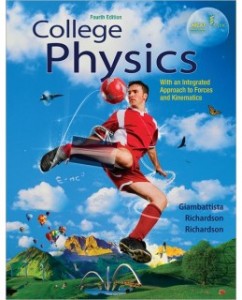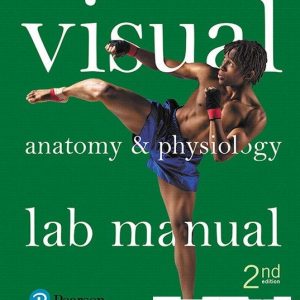Instant download Test Bank for College Physics, 4th Edition: Alan Giambattista pdf docx epub after payment.

Product details:
- ISBN-10 : 0073512141
- ISBN-13 : 978-0073512143
- Author: Alan Giambattista; Betty McCarthy Richardson
College Physics, Fourth Edition, presents a unique “forces first” approach to physics that builds a conceptual framework as motivation for the physical principles. That intuitive approach, combined with a consistent problem solving strategies, stunning art, extensive end-of-chapter material, and superior media support make Giambattista, Richardson, and Richardson a product that addresses the needs of TODAY’s students.
Table of contents:
- Chapter 1: Introduction
- 1.1: Why Study Physics?
- 1.2: Talking Physics
- 1.3: The Use of Mathematics
- 1.4: Scientific Notation and Significant Figures
- 1.5: Units
- 1.6: Dimensional Analysis
- 1.7: Problem-Solving Techniques
- 1.8: Approximation
- 1.9: Graphs
- Collaborative Problems
- Comprehensive Problems
- Problems
- Problems
- Problems
- Problems (86)
- Multiple-Choice Questions (4)
- Conceptual Questions
- Chapter 2: Force
- 2.1: Interactions and Forces
- 2.2: Graphical Vector Addition
- 2.3: Vector Addition Using Components
- 2.4: Inertia and Equilibrium: Newton’s First Law of Motion
- 2.5: Interaction Pairs: Newton’s Third Law of Motion
- 2.6: Gravitational Forces
- 2.7: Contact Forces
- 2.8: Tension
- 2.9: Fundamental Forces
- Collaborative Problems
- Comprehensive Problems
- Problems
- Problems
- Problems
- Problems (103)
- Multiple-Choice Questions (4)
- Conceptual Questions
- Chapter 3: Acceleration and Newton’s Second Law of Motion
- 3.1: Position and Displacement
- 3.2: Velocity
- 3.3: Acceleration and Newton’s Second Law of Motion
- 3.4: Applying Newton’s Laws
- 3.5: Velocity is Relative; Reference Frames
- Collaborative Problems
- Comprehensive Problems
- Problems
- Problems
- Problems
- Problems (92)
- Multiple-Choice Questions (4)
- Conceptual Questions
- Chapter 4: Motion with Constant Acceleration
- 4.1: Motion Along a Line when the Net Force is Constant
- 4.2: Kinematic Equations For Motion Along a Line With Constant Acceleration
- 4.3: Applying Newton’s Laws With Constant-Acceleration Kinematics
- 4.4: Free Fall
- 4.5: Motion of Projectiles
- 4.6: Apparent Weight
- Collaborative Problems
- Comprehensive Problems
- Problems
- Problems
- Problems
- Problems (75)
- Multiple-Choice Questions (4)
- Conceptual Questions
- Chapter 5: Circular Motion
- 5.1: Description of Uniform Circular Motion
- 5.2: Radial Acceleration
- 5.3: Unbanked and Banked Curves
- 5.4: Circular Orbits of Satellites and Planets
- 5.5: Nonuniform Circular Motion
- 5.6: Angular Acceleration
- 5.7: Apparent Weight and Artificial Gravity
- Collaborative Problems
- Comprehensive Problems
- Problems
- Problems
- Problems
- Problems (79)
- Multiple-Choice Questions (4)
- Conceptual Questions
- Chapter 6: Conservation of Energy
- 6.1: Preview of the Law of Conservation of Energy
- 6.2: Work Done by a Constant Force
- 6.3: Kinetic Energy
- 6.4: Gravitational Potential Energy (1)
- 6.5: Gravitational Potential Energy (2)
- 6.6: Work Done by Variable Forces
- 6.7: Elastic Potential Energy
- 6.8: Power
- Collaborative Problems
- Comprehensive Problems
- Problems
- Problems
- Problems
- Problems (108)
- Multiple-Choice Questions (4)
- Conceptual Questions
- Chapter 7: Linear Momentum
- 7.1: A Conservation Law For a Vector Quantity
- 7.2: Momentum
- 7.3: The Impulse-Momentum Theorem
- 7.4: Conservation of Momentum
- 7.5: Center of Mass
- 7.6: Motion of the Center of Mass
- 7.7: Collisions in One Dimension
- 7.8: Collisions in Two Dimensions
- Collaborative Problems
- Comprehensive Problems
- Problems
- Problems
- Problems
- Problems (96)
- Multiple-Choice Questions (4)
- Conceptual Questions
- Chapter 8: Torque and Angular Momentum
- 8.1: Rotational Kinetic Energy and Rotational Inertia
- 8.2: Torque
- 8.3: Calculating Work Done from the Torque
- 8.4: Rotational Equilibrium
- 8.5: Application: Equilibrium in the Human Body
- 8.6: Rotational Form of Newton’s Second Law
- 8.7: The Motion of Rolling Objects
- 8.8: Angular Momentum
- 8.9: The Vector Nature of Angular Momentum
- Collaborative Problems
- Comprehensive Problems
- Problems
- Problems
- Problems
- Problems (115)
- Multiple-Choice Questions (4)
- Conceptual Questions
- Chapter 9: Fluids
- 9.1: States of Matter
- 9.2: Pressure
- 9.3: Pascal’s Principle
- 9.4: The Effect of Gravity on Fluid Pressure
- 9.5: Measuring Pressure
- 9.6: The Buoyant Force
- 9.7: Fluid Flow
- 9.8: Bernoulli’s Equation
- 9.9: Viscosity
- 9.10: Viscous Drag
- 9.11: Surface Tension
- Collaborative Problems
- Comprehensive Problems
- Problems
- Problems
- Problems
- Problems (99)
- Multiple-Choice Questions (4)
- Conceptual Questions
- Chapter 10: Elasticity and Oscillations
- 10.1: Elastic Deformations of Solids
- 10.2: Hooke’s Law for Tensile and Compressive Forces
- 10.3: Beyond Hooke’s Law
- 10.4: Shear and Volume Deformations
- 10.5: Simple Harmonic Motion
- 10.6: The Period and Frequency For SHM
- 10.7: Graphical Analysis of SHM
- 10.8: The Pendulum
- 10.9: Damped Oscillations
- 10.10: Forced Oscillations and Resonance
- Collaborative Problems
- Comprehensive Problems
- Problems
- Problems
- Problems
- Problems (93)
- Multiple-Choice Questions (4)
- Conceptual Questions
- Chapter 11: Waves
- 11.1: Waves and Energy Transport
- 11.2: Transverse and Longitudinal Waves
- 11.3: Speed of Transverse Waves on a String
- 11.4: Periodic Waves
- 11.5: Mathematical Description of a Wave
- 11.6: Graphing Waves
- 11.7: Principle of Superposition
- 11.8: Reflection and Refraction
- 11.9: Interference and Diffraction
- 11.10: Standing Waves
- Collaborative Problems
- Comprehensive Problems
- Problems
- Problems
- Problems
- Problems (54)
- Multiple-Choice Questions (3)
- Conceptual Questions
- Chapter 12: Sound
- 12.1: Sound Waves
- 12.2: The Speed of Sound Waves
- 12.3: Amplitude and Intensity of Sound Waves
- 12.4: Standing Sound Waves
- 12.5: Timbre
- 12.6: The Human Ear
- 12.7: Beats
- 12.8: The Doppler Effect
- 12.9: Echolocation and Medical Imaging
- Collaborative Problems
- Comprehensive Problems
- Problems
- Problems
- Problems
- Problems (57)
- Multiple-Choice Questions (3)
- Conceptual Questions
- Chapter 13: Temperature and the Ideal Gas
- 13.1: Temperature and Thermal Equilibrium
- 13.2: Temperature Scales
- 13.3: Thermal Expansion of Solids and Liquids
- 13.4: Molecular Picture of a Gas
- 13.5: Absolute Temperature and the Ideal Gas Law
- 13.6: Kinetic Theory of the Ideal Gas
- 13.7: Temperature and Reaction Rates
- 13.8: Diffusion
- Collaborative Problems
- Comprehensive Problems
- Problems
- Problems
- Problems
- Problems (76)
- Multiple-Choice Questions (3)
- Conceptual Questions
- Chapter 14: Heat
- 14.1: Internal Energy
- 14.2: Heat
- 14.3: Heat Capacity and Specific Heat
- 14.4: Specific Heat of Ideal Gases
- 14.5: Phase Transitions
- 14.6: Thermal Conduction
- 14.7: Thermal Convection
- 14.8: Thermal Radiation
- Collaborative Problems
- Comprehensive Problems
- Problems
- Problems
- Problems
- Problems (89)
- Multiple-Choice Questions (3)
- Conceptual Questions
- Chapter 15: Thermodynamics
- 15.1: The First Law of Thermodynamics
- 15.2: Thermodynamic Processes
- 15.3: Thermodynamic Processes for an Ideal Gas
- 15.4: Reversible and Irreversible Processes
- 15.5: Heat Engines
- 15.6: Refrigerators and Heat Pumps
- 15.7: Reversible Engines and Heat Pumps
- 15.8: Entropy
- 15.9: The Third Law of Thermodynamics
- Collaborative Problems
- Comprehensive Problems
- Problems
- Problems
- Problems
- Problems (62)
- Multiple-Choice Questions (3)
- Conceptual Questions
- Chapter 16: Electric Forces and Fields
- 16.1: Electric Charge
- 16.2: Electric Conductors and Insulators
- 16.3: Coulomb’s Law
- 16.4: The Electric Field
- 16.5: Motion of a Point Charge in a Uniform Electric Field
- 16.6: Conductors in Electrostatic Equilibrium
- 16.7: Gauss’s Law For Electric Fields
- Collaborative Problems
- Comprehensive Problems
- Problems
- Problems
- Problems
- Problems (97)
- Multiple-Choice Questions (3)
- Conceptual Questions
- Chapter 17: Electric Potential
- 17.1: Electric Potential Energy
- 17.2: Electric Potential
- 17.3: The Relationship Between Electric Field and Potential
- 17.4: Conservation of Energy for Moving Charges
- 17.5: Capacitors
- 17.6: Dielectrics
- 17.7: Energy Stored in a Capacitor
- Collaborative Problems
- Comprehensive Problems
- Problems
- Problems
- Problems
- Problems (117)
- Multiple-Choice Questions (3)
- Conceptual Questions
- Chapter 18: Electric Current and Circuits
- 18.1: Electric Current
- 18.2: Emf and Circuits
- 18.3: Microscopic View of Current in a Metal: The Free-Election Model
- 18.4: Resistance and Resistivity
- 18.5: Kirchhoff’s Rules
- 18.6: Series and Parallel Circuits
- 18.7: Circuit Analysis Using Kirchhoff’s Rules
- 18.8: Power and Energy in Circuits
- 18.9: Measuring Currents and Voltages
- 18.10: RC Circuits
- 18.11: Electrical Safety
- Collaborative Problems
- Comprehensive Problems
- Problems
- Problems
- Problems
- Problems (135)
- Multiple-Choice Questions (3)
- Conceptual Questions
- Chapter 19: Magnetic Forces and Fields
- 19.1: Magnetic Fields
- 19.2: Magnetic Force on a Point Charge
- 19.3: Charged Particle Moving Perpendicularly to a Uniformed Magnetic Field
- 19.4: Motion of a Charged Particle in a Uniform Magnetic Field: General
- 19.5: A Charged Particle in Crossed E→ and B→ Fields
- 19.6: Magnetic Force on a Current-Carrying Wire
- 19.7: Torque on a Current Loop
- 19.8: Magnetic Field Due to an Electric Current
- 19.9: Ampère’s Law
- 19.10: Magnetic Materials
- Collaborative Problems
- Comprehensive Problems
- Problems
- Problems
- Problems
- Problems (119)
- Multiple-Choice Questions (3)
- Conceptual Questions
- Chapter 20: Electromagnetic Induction
- 20.1: Motional Emf
- 20.2: Electric Generators
- 20.3: Faraday’s Law
- 20.4: Lenz’s Law
- 20.5: Back Emf in a Motor
- 20.6: Transformers
- 20.7: Eddy Currents
- 20.8: Induced Electric Fields
- 20.9: Inductance
- 20.10: LR Circuits
- Collaborative Problems
- Comprehensive Problems
- Problems
- Problems
- Problems
- Problems (72)
- Multiple-Choice Questions (3)
- Conceptual Questions
People also search:
College Physics
College Physics Alan Giambattista
College Physics Alan Giambattista 4th
College Physics Alan Giambattista 4th Test Bank
Test Bank for College Physics, 4th Edition: Alan Giambattista Download





